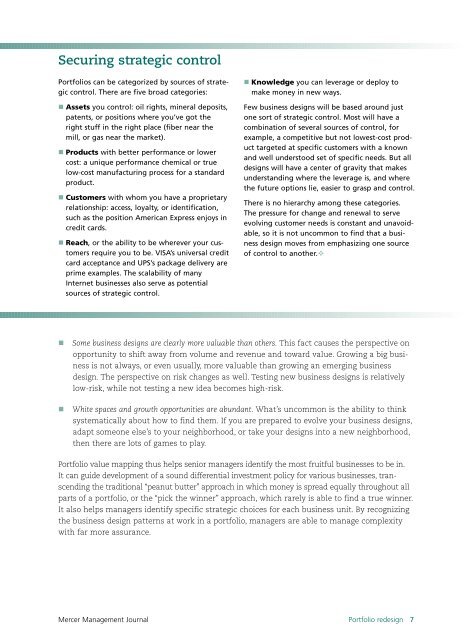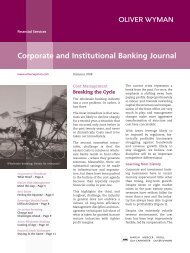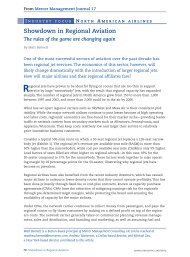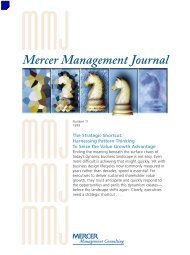Download the Report - Oliver Wyman
Download the Report - Oliver Wyman
Download the Report - Oliver Wyman
Create successful ePaper yourself
Turn your PDF publications into a flip-book with our unique Google optimized e-Paper software.
Securing strategic control<br />
Portfolios can be categorized by sources of strategic<br />
control. There are five broad categories:<br />
T Assets you control: oil rights, mineral deposits,<br />
patents, or positions where you’ve got <strong>the</strong><br />
right stuff in <strong>the</strong> right place (fiber near <strong>the</strong><br />
mill, or gas near <strong>the</strong> market).<br />
T Products with better performance or lower<br />
cost: a unique performance chemical or true<br />
low-cost manufacturing process for a standard<br />
product.<br />
T Customers with whom you have a proprietary<br />
relationship: access, loyalty, or identification,<br />
such as <strong>the</strong> position American Express enjoys in<br />
credit cards.<br />
T Reach, or <strong>the</strong> ability to be wherever your customers<br />
require you to be. VISA’s universal credit<br />
card acceptance and UPS’s package delivery are<br />
prime examples. The scalability of many<br />
Internet businesses also serve as potential<br />
sources of strategic control.<br />
T Knowledge you can leverage or deploy to<br />
make money in new ways.<br />
Few business designs will be based around just<br />
one sort of strategic control. Most will have a<br />
combination of several sources of control, for<br />
example, a competitive but not lowest-cost product<br />
targeted at specific customers with a known<br />
and well understood set of specific needs. But all<br />
designs will have a center of gravity that makes<br />
understanding where <strong>the</strong> leverage is, and where<br />
<strong>the</strong> future options lie, easier to grasp and control.<br />
There is no hierarchy among <strong>the</strong>se categories.<br />
The pressure for change and renewal to serve<br />
evolving customer needs is constant and unavoidable,<br />
so it is not uncommon to find that a business<br />
design moves from emphasizing one source<br />
of control to ano<strong>the</strong>r.c<br />
TSome business designs are clearly more valuable than o<strong>the</strong>rs. This fact causes <strong>the</strong> perspective on<br />
opportunity to shift away from volume and revenue and toward value. Growing a big business<br />
is not always, or even usually, more valuable than growing an emerging business<br />
design. The perspective on risk changes as well. Testing new business designs is relatively<br />
low-risk, while not testing a new idea becomes high-risk.<br />
TWhite spaces and growth opportunities are abundant. What’s uncommon is <strong>the</strong> ability to think<br />
systematically about how to find <strong>the</strong>m. If you are prepared to evolve your business designs,<br />
adapt someone else’s to your neighborhood, or take your designs into a new neighborhood,<br />
<strong>the</strong>n <strong>the</strong>re are lots of games to play.<br />
Portfolio value mapping thus helps senior managers identify <strong>the</strong> most fruitful businesses to be in.<br />
It can guide development of a sound differential investment policy for various businesses, transcending<br />
<strong>the</strong> traditional “peanut butter” approach in which money is spread equally throughout all<br />
parts of a portfolio, or <strong>the</strong> “pick <strong>the</strong> winner” approach, which rarely is able to find a true winner.<br />
It also helps managers identify specific strategic choices for each business unit. By recognizing<br />
<strong>the</strong> business design patterns at work in a portfolio, managers are able to manage complexity<br />
with far more assurance.<br />
Mercer Management Journal Portfolio redesign 7
















